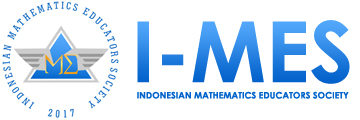EKPLORASI ETNOMATEMATIKA PADA BANGUNAN BERSEJARAH BENDUNGAN WALAHAR TERHADAP PEMBELAJARAN MATEMATIKA
DOI:
https://doi.org/10.35706/sjme.v8i2.11127Abstract
The mathematics learning process will be effective if there is social and cultural interaction through dialogue, language and representation of symbolic meaning in mathematics. Therefore, integrating ethnomathematics as a cultural value is part of representing real environmental objects in mathematical concepts. The aim of this research is to explore mathematical concepts in the historical building of the Walahar Dam and the implications for mathematics learning. This type of research uses descriptive exploratory. Research data was collected through interviews, observation and documentation. Meanwhile, the data analysis carried out was analyzing flat shapes which were adapted to mathematics learning. The results of this research can be concluded that one of the cultural heritage heritage of the Netherlands is a historical building, namely the Walahar Dam which has flat shapes such as an isosceles triangle, circle, rectangle and a flat shape that is a combination of a rectangle and a semi-circle. To encourage students to actively participate in exploring sources that are relevant to the material being studied. This allows students to connect the contextual environment and their knowledge experiences when learning mathematics.
Downloads
References
Anista, R., & Marsigit, M. (2020). Direct identification of Borobudur temple artefacts for learning flat shapes concepts. Journal of Physics: Conference Series, 1613(1). https://doi.org/10.1088/1742-6596/1613/1/012021
Astuti, N. D., & Octaviani, S. (2023). MENINGKATKAN HASIL BELAJAR MATEMATIKA MELALUI MODEL PEMBELAJARAN MATEMATIKA REALISTIK BERBASIS TEORI BELAJAR BRUNER. Jurnal Review Pendidikan Dan Pengajaran, 6(2), 571–575.
Daud, A. C., Mangobi, J. U. L., & Monoarfa, J. F. (2023). Application Of Problem-Based Learning Models In Flat Shape Learning. Jurnal Pendidikan Tambusai, 7, 17030–17036. https://mail.jptam.org/index.php/jptam/article/view/9069%0Ahttps://mail.jptam.org/index.php/jptam/article/download/9069/7408
Ditasona, C. (2018). Ethnomathematics Exploration of the Toba Community: Elements of Geometry Transformation Contained in Gorga (Ornament on Bataks House). IOP Conference Series: Materials Science and Engineering, 335(1). https://doi.org/10.1088/1757-899X/335/1/012042
Fauzi, A., & Lu’luilmaknun, U. (2019). Etnomatematika Pada Permainan Dengklaq Sebagai Media Pembelajaran Matematika. AKSIOMA: Jurnal Program Studi Pendidikan Matematika, 8(3), 408. https://doi.org/10.24127/ajpm.v8i3.2303
Lusiana, D., Afriani, N. H., Ardy, H., & Widada, W. (2019). Eksplorasi Etnomatematika Pada Masjid Jamik Kota Bengkulu. Jurnal Pendidikan Matematika Raflesia, 04(02), 164–176. https://www.kemdikbud.go.id
Mustika, A., & Utomo, H. (2023). TINJAUAN EUTROFIKASI TERHADAP BANGUNAN IRIGASI (STUDI KASUS BENDUNG WALAHAR, KABUPATEN KARAWANG). JURNAL JERNIH, 01(1), 53–65.
Najah, E. F., & Nurhalimah, A. (2023). Implementasi Teori Belajar Matematika terhadap Keberhasilan Belajar Siswa. Seminar Nasional Paedagoria Universitas, 3, 98–104.
Nova, I. S., & Putra, A. (2022). Eksplorasi Etnomatematika pada Cerita Rakyat. Plusminus: Jurnal Pendidikan Matematika, 2(1), 67–76. https://doi.org/10.31980/plusminus.v2i1.1497
Nur Alvian, D., Agustito, D., Astuti Arigiyati, T., Harini, E., & Adi Widodo, S. (2021). Identifying geometrical objects in Sumur Gumuling Tamansari: An ethnomathematics analysis. Journal of Physics: Conference Series, 1778(1). https://doi.org/10.1088/1742-6596/1778/1/012021
Pakpahan, T. F., Retta, A. M., Tika, D., & Nopriyanti, D. (2023). Analisis Materi Aritmetika Sosial Menggunakan Konteks Literasi Finansial. SJME (Supremum Journal of Mathematics Education), 07(01), 1–14.
Pathuddin, H., Nawawi, M. I., & Kamariah. (2021). BUGINESE ETHNOMATHEMATICS: BARONGKO CAKE EXPLORATIONS AS MATHEMATICS LEARNING RESOURCES. Journal on Mathematics Education, 12(2), 295–312.
Prahmana, R. C. I., & D’Ambrosio, U. (2020). Learning geometry and values from patterns: Ethnomathematics on the batik patterns of yogyakarta, indonesia. Journal on Mathematics Education, 11(3), 439–456. https://doi.org/10.22342/jme.11.3.12949.439-456
Pratiwi, J. W., & Pujiastuti, H. (2020). Eksplorasi Etnomatematika pada Permainan Tradisional Kelereng. Jurnal Pendidikan Matematika Raflesia, 5(2), 1–12. https://ejournal.unib.ac.id/index.php/jpmr/article/view/11405
Purniati, T., Turmudi, T., Juandi, D., & Suhaedi, D. (2021). Ethnomathematics Exploration of The Masjid Raya Bandung Ornaments in Transformation Geometry Materials. Journal of Medives : Journal of Mathematics Education IKIP Veteran Semarang, 5(2), 235. https://doi.org/10.31331/medivesveteran.v5i2.1639
Rosita, R., Asfida, A., Annur, M. A., & Azis, A. (2020). Eksplorasi Etnomatematika pada Benteng Keraton Buton dan Implikasinya pada Pembelajaran Matematika. Jurnal Akademik Pendidikan Matematika, 6, 86–90. https://doi.org/10.55340/japm.v6i2.260
Safitri, A. H. I., Novaldin, I. D., & Supiarmo, M. G. (2021). Eksplorasi Etnomatematika pada Bangunan Tradisional Uma Lengge. Jurnal Cendekia : Jurnal Pendidikan Matematika, 5(3), 3311–3321. https://doi.org/10.31004/cendekia.v5i3.851
Sari, A. K., Budiarto, M. T., & Ekawati, R. (2022). Ethnomathematics study: cultural values and geometric concepts in the traditional “tanean-lanjang” house in Madura – Indonesia. JRAMathEdu (Journal of Research and Advances in Mathematics Education), 7(1), 46–54. https://doi.org/10.23917/jramathedu.v7i1.15660
Sarwoedi, Marinka, D. O., Febriani, P., & Wirne, I. N. (2018). Efektifitas etnomatematika dalam meningkatkan kemampuan pemahaman matematika siswa. Jurnal Pendidikan Matematika Raflesia, 03(02), 171–176. https://ejournal.unib.ac.id/index.php/jpmr/article/view/7521
Setiana, D. S., Ayuningtyas, A. D., Wijayanto, Z., & Kusumaningrum, B. (2021). Eksplorasi etnomatematika Museum Kereta Kraton Yogyakarta dan pengintegrasiannya ke dalam pembelajaran matematika. Ethnomathematics Journal, 2(1), 1–10. https://doi.org/10.21831/ej.v2i1.36210
Soebagyo, J., & Haya, A. F. (2023). Eksplorasi Etnomatematika terhadap Masjid Jami Cikini Al- Ma ’ mur sebagai Media d alam Penyampaian Konsep Geometri. Mathema Journal, 5(2), 235–257. https://ejurnal.teknokrat.ac.id/index.php/jurnalmathema/article/view/2866/1238
Sudirman, S., Yaniawati, R. P., Melawaty, M., & Indrawan, R. (2020). Integrating ethnomathematics into augmented reality technology: Exploration, design, and implementation in geometry learning. Journal of Physics: Conference Series, 1521(3). https://doi.org/10.1088/1742-6596/1521/3/032006
Sugi, S., & Soebagyo, J. (2022). Ethnomathematics Exploration of Cemetery of Heroes in City Kampung Mesjid Labuhanbatu Utara. Jurnal Analisa, 8(2), 142–151. https://doi.org/10.15575/ja.v8i2.19182
Tarihoran, D., Nau Ritonga, M., & Lubis, R. (2021). Teori Belajar Robert Mills Gagne Dan Penerapan Dalam Pembelajaran Matematika. JURNAL MathEdu (Mathematic Education Journal), 4(3), 32–38. https://doi.org/10.37081/mathedu.v4i3.2242
Tegar, W. P., Muchyidin, A., & Nursuprianah, I. (2022). Macan Ali In The Cirebon Glass Painting: The Study Of Ethnomathematics. Journal of Mathematics Instruction, Social Research and Opinion, 1(1), 27–40. https://doi.org/10.58421/misro.v1i1.9
Wardani, A. K., Islam, U., Raden, N., Palembang, F., & Selatan, S. (2024). Bagaimana Respon Siswa terhadap E-Modul Matematika dengan Konteks Budaya Sumatera Selatan ? SJME (Supremum Journal of Mathematics Education), 08(01), 73–86. https://doi.org/10.35706/sjme.v8i1.10787
Downloads
Published
How to Cite
Issue
Section
License

This work is licensed under a Creative Commons Attribution-ShareAlike 4.0 International License.
Authors who publish with this journal agree to the following terms:
- Authors retain copyright and grant the journal right of first publication with the work simultaneously licensed under a Creative Commons Attribution License that allows others to share the work with an acknowledgment of the work's authorship and initial publication in this journal.
- Authors are able to enter into separate, additional contractual arrangements for the non-exclusive distribution of the journal's published version of the work (e.g., post it to an institutional repository or publish it in a book), with an acknowledgment of its initial publication in this journal.
- Authors are permitted and encouraged to post their work online (e.g., in institutional repositories or on their website) prior to and during the submission process, as it can lead to productive exchanges, as well as earlier and greater citation of published work (See The Effect of Open Access).










